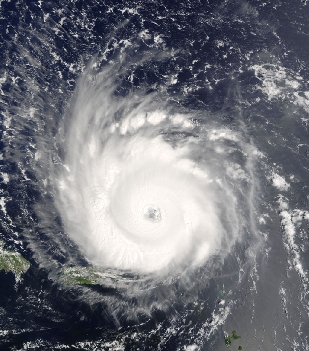

Mission Status Report #77 Star Date: October 11, 2004
Rough Hurricane Season in the CarribeanCaption: In late August 2004, Hurricane Francis rumbles just northeast of Puerto Rico, where the primary FUSE ground station is located (in Mayaguez). Image from the MODIS instrument on the TERRA satellite. (Photo courtesy NASA.)
Operations on the FUSE satellite continue to go well since my last report, although not without some challenges. You may recall that the primary FUSE ground station is located at the University of Puerto Rico, Mayaguez, on the western coast of the island. With the active hurricane season this year, it has been a bit nerve-wracking watching monster hurricanes bouncing around the Carribean, wreaking havoc as they went. While no direct hits were taken by Puerto Rico, we were reminded that it doesn't take a direct hit to cause significant problems. Heavy rains and thunderstorms associated with hurricane Francis (shown above) caused widespread power outages and took our ground station off line. Later in September, a direct lightning strike during a storm spawned by hurricane Jeanne knocked out several key pieces of electronic equipment (despite the usual safeguards that were in place), and caused us to scramble to get the ground station back on line. Special thanks go to our colleagues at the University of Puerto Rico for their heroic efforts on out behalf, and for the techicians at Honeywell Technical Services, Inc. (HTSI), who made an important house call to the ground station to effect repairs. In another interesting turn of events, although operations continue unabated, FUSE has developed problems with another one of its ring-laser gyroscopes. You may recall, FUSE has two "Inertial Reference Units" (IRUs) each of which contains three gyros. When a first gyro went bad in IRU-A, we switched over to the IRU-B package. We then developed new flight control software that could work with less than three gyros (and NO gyros, if that time ever comes). This new software was loaded to the spacecraft in April 2003, and thoroughly tested. As reported in Status Report #70, when we lost a gyro in IRU-B in late July 2003, we kept right on operating with only two active gyros in the control loop. That's the way we operated until just recently. Over the summer, analysis of detailed pointing data during science observations started to show an increase in what we call pointing jitter, which is the small scale pointing errors that occur all the time. Although not at a level that it would affect the quality of science data, we nonetheless started efforts to try and understand where the jitter was arising within the control system. It turns out that a second gyro in IRU-B has shown a degradation in performance to the point that, by mid-September 2004 it was causing difficulties to target acquisitions. This behavior is entirely different from the other gyros that failed, which worked perfectly right up to when they finally stopped operationing. After some final attempts to clear up the problem we decided to remove the problem gyro from the control loop on Sept. 28, 2004. We have continued operating, now in single-gyro mode, since that time, and have seen no ill-effects. But we are watching things very closely as we continue normal science operations. Such is life with an aging satellite! The deadline for Cycle 6 FUSE proposals was Sept. 17, 2004. NASA received a record number of new proposals for potential observation in Cycle 6, for a record amount of requested time. Competition will be stiff, but we take this as a good sign that the astronomical community still holds a keen interest in new FUSE observations! Proposal selections will be made later this fall with results announced near the end of the year. Good luck to those who proposed!
Reported by: Bill Blair, FUSE Chief of Observatory Operations
|
